Boeing AH-64 Apache Video - Agility Demo & Firing Rockets
|
|
Boeing AH-64 Apache
AH-64 Apache
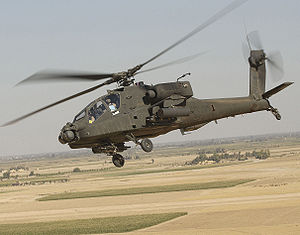
Picture - A radar-less AH-64D Longbow Apache from U.S. Army's 101st Aviation Regiment in Iraq
Role: Attack helicopter
National origin: United States
Manufacturer: Hughes Helicopters
McDonnell Douglas
Boeing Defense, Space & Security
First flight: 30 September 1975
Introduced: April 1986
Status: Active service
Primary users: United States Army
Israel Air Force
Royal Netherlands Air Force
Japan Ground Self-Defense Force
Produced: 1983-present
Number built: 1,174 as of February 2010
Unit cost: AH-64A: US$20 million (2007),
AH-64D (AH-64A upgrade): US$18 million (2007)
Variants: AgustaWestland Apache
The Boeing AH-64 Apache is a four-blade, twin-engine attack helicopter with tailwheel-type landing gear arrangement, and tandem cockpit for a crew of two. The Apache was developed as Model 77 by Hughes Helicopters for the United States Army's Advanced Attack Helicopter program to replace the AH-1 Cobra. First flown on 30 September 1975, the AH-64 features a nose-mounted sensor suite for target acquisition and night vision systems. The Apache is armed with a 30-millimeter (1.2 in) M230 Chain Gun carried between the main landing gear, under the aircraft's forward fuselage. It has four hardpoints mounted on stub-wing pylons, typically carrying a mixture of AGM-114 Hellfire and Hydra 70 rocket pods. The AH-64 also features double- and triple-redundant aircraft systems to improve survivability for the aircraft and crew in combat, as well as improved crash survivability for the pilots.
The U.S. Army selected the AH-64 over the Bell YAH-63 in 1976, awarding Hughes Helicopters a pre-production contract for two more aircraft. In 1982, the Army approved full production. McDonnell Douglas continued production and development after purchasing Hughes Helicopters from Summa Corporation in 1984. The first production AH-64D Apache Longbow, a greatly upgraded version of the original Apache, was delivered to the Army in March 1997. AH-64 production is continued by the Boeing Defense, Space & Security division; over one thousand AH-64s have been produced to date.
The U.S. Army is the primary operator of the AH-64, however it has also become the primary attack helicopter of several nations it has been exported to, including the United Kingdom, Israel, Japan, Greece and the Netherlands. U.S. AH-64s have served in conflicts in Panama, Persian Gulf War, Afghanistan, and Iraq. Israel has made active use of the Apache in its military conflicts in Lebanon and Gaza Strip; while two coalition allies have deployed their AH-64s in Afghanistan and Iraq.
Development
Advanced Attack Helicopter
Following the cancellation of the AH-56 Cheyenne in 1972, in favor of United States Air Force and Marine Corps projects like the A-10 Thunderbolt II and Harrier Jump Jet, the United States Army sought an aircraft to fill an anti-armor attack role that would still be under Army command; the 1948 Key West Agreement forbade the Army from owning fixed-wing aircraft. The Army wanted an aircraft better than the AH-1 Cobra in firepower, performance and range. It would have the maneuverability for terrain following nap-of-the-earth (NoE) flying. To this end, the US Army issued a Request For Proposals (RFP) for an Advanced Attack Helicopter (AAH) on 15 November 1972. As a sign of the importance of this project, in September 1973 the Army designated their five most important projects, the "Big Five" with AAH included.
Proposals were submitted by five manufacturers: Bell, Boeing Vertol (teamed with Grumman), Hughes, Lockheed, and Sikorsky. In July 1973, the U.S. Department of Defense selected finalists Bell and Hughes Aircraft's Toolco Aircraft Division (later Hughes Helicopters). This began the phase 1 of the competition. Each company built prototype helicopters and went through a flight test program. Hughes' Model 77/YAH-64A prototype first flew on 30 September 1975, while Bell's Model 409/YAH-63A prototype first flew on 1 October. After evaluating test results, the Army selected Hughes' YAH-64A over Bell's YAH-63A in 1976. Reasons for selecting the YAH-64A included its more damage tolerant four-blade main rotor and the instability of the YAH-63's tricycle landing gear arrangement.
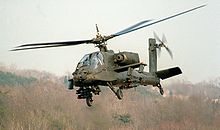
Picture - A Hughes YAH-64A prototype
The AH-64A then entered phase 2 of the AAH program. This called for building three pre-production AH-64s, and upgrading the two YAH-64A flight prototypes and the ground test unit up to the same standard. Weapons and sensor systems were integrated and tested during this time, including the new Hellfire missile.
Into production
In 1981, three pre-production AH-64As were handed over to the US Army for Operational Test II. The Army testing was successful, but afterward it was decided to upgrade to the more powerful T700-GE-701 version of engine, rated at 1,690 shp (1,259 kW). The AH-64 was named the Apache in late 1981, keeping with the Army's traditional use of American Indian tribal names for its helicopters and it was approved for full scale production in 1982. In 1983, the first production helicopter was rolled out at Hughes Helicopter's facility at Mesa, Arizona. Hughes Helicopters was purchased by McDonnell Douglas for $470 million in 1984. The helicopter unit later became part of The Boeing Company with the merger of Boeing and McDonnell Douglas in August 1997. In 1986, the incremental or flyaway cost for the AH-64A was US$7.03 million and the average unit cost was approximately US$13.9 million based on total costs.
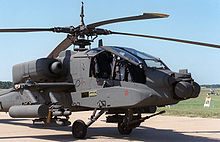
Picture - A YAH-64 in 1984
In the mid-1980s, McDonnell Douglas studied an improved "AH-64B" design with an updated cockpit, new fire control system and other upgrades. In 1988 funding was approved for a multi-stage upgrade program to improve sensor and weapon avionic systems and incorporate some digital systems. However, improved technology was becoming available. It was decided to cancel the upgrade program for more ambitious changes. This would lead to the more advanced AH-64D Apache Longbow. Development of the AH-64D was approved by the Defense Acquisition Board in August 1990. The first AH-64D Apache Longbow prototype was flown on 15 April 1992, and testing of the prototypes ended in April 1995 after they had significantly outperformed the AH-64A model. On 13 October 1995 full-scale production of the Apache Longbow was approved and a $1.9 billion five year contract was signed in August 1996 to upgrade and rebuild 232 existing AH-64 Apaches. The first production AH-64D flew on 17 March 1997 and was delivered on 31 March 1997. The cost of the AH-64D program totaled US$11 billion through 2007.
Design
The Apache has a four-blade main rotor and a four-blade tail rotor. The crew sits in tandem, with the pilot sitting behind and above the copilot/gunner. The crew compartment and fuel tanks are armored such that the aircraft will remain flyable even after sustaining hits from 23-millimeter (0.91 in) gunfire.
The AH-64 is powered by two General Electric T700 turboshaft engines with high-mounted exhausts on either side of the fuselage. Various models of engines have been used on the Apache, those in British service use engines from Rolls-Royce instead of General Electric. In 2004, General Electric Aviation began producing more powerful T700-GE-701D engines, rated at 2,000 shp (1,500 kW) for AH-64Ds.
One of the revolutionary features at the introduction of the Apache was its helmet mounted display, the Integrated Helmet and Display Sighting System (IHADSS); among other abilities the pilot or gunner can slave the helicopter's 30 mm automatic M230 Chain Gun to his helmet, making the gun track head movements to point at where he looks. The M230E1 can be alternatively fixed to a locked forward firing position, or controlled via the Target Acquisition and Designation System (TADS).
The AH-64 is designed to endure front-line environments and to operate during the day or night and in adverse weather using avionics, such as the Target Acquisition and Designation System, Pilot Night Vision System (TADS/PNVS), passive infrared countermeasures, GPS, and the IHADSS. A newer system that is replacing TADS/PNVS is Arrowhead (MTADS); it is manufactured by Lockheed Martin, a contract was made on 17 February 2005 to begin equipping all models of American Apaches.
The AH-64 is adaptable to numerous different roles within its context as Close Combat Attack (CCA), and has a customizable weapons loadout for the role desired. In addition to the 30-mm M230E1 Chain Gun, the Apache carries a range of external stores on its stub-wing pylons, typically a mixture of AGM-114 Hellfire anti-tank missiles, and Hydra 70 general-purpose unguided 70 mm (2.76 in) rockets. The Stinger and AIM-9 Sidewinder air-to-air missiles and the AGM-122 Sidearm anti-radiation missile were evaluated beginning in the late 1980s. The Stinger was initially selected over the AIM-9, but the US Army is considering the Starstreak air-to-air missile instead. The stub-wing pylons also have mounting points for use during ground helicopter maintenance; though in case of emergency the mount points can be used for harnessing personnel to the wings during transport. External fuel tanks can also be carried by the pylons to increase range and mission time.
Operational history
United States Army
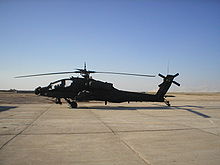
Picture - AH-64A at Forward Operating Base Speicher, Iraq in 2005
The U.S. Army formally accepted its first production AH-64A in January 1984 and training of the first pilots began later that year. The first operational Apache unit, 7th Battalion, 17th Cavalry Brigade, began training on the AH-64A in April 1986 at Fort Hood, Texas. Two operational units with 68 AH-64s first deployed to Europe in September 1987 and took part in large military exercises there. The helicopter was first used in combat in 1989, during Operation Just Cause, the invasion of Panama. The AH-64 participated in over 240 hours of combat attacking various targets, mostly at night.
During Operation Desert Storm on 17 January 1991, eight AH-64As guided by four MH-53 Pave Low IIIs, were used to destroy a portion of the Iraqi radar network. This was the first attack of Desert Storm and it allowed attack aircraft into Iraq without detection. The Apaches carried an asymmetric load of Hydra 70 flechette rockets, Hellfires, and one auxiliary fuel tank each. During the 100-hour ground war a total of 277 AH-64s took part, destroying over 500 tanks, numerous armored personnel carriers and other Iraqi vehicles. Only one AH-64 was lost in the war. It was hit by an RPG at close range and crashed, but the crew survived.
The AH-64 played roles in the Balkans during separate conflicts in Bosnia and Kosovo in the 1990s. During these deployments the Apache encountered problems such as deficiencies in training, night vision equipment, fuel tanks, and survivability. On 27 April 1999 an Apache crashed during training in Albania due to a failure with the tail rotor, causing the entire fleet in the Balkans to be grounded in December 2000. Major General Dick Cody, commanding officer of the 101st Airborne at the time, wrote a strongly worded memo to the US Army Chief of Staff about the failures in training and equipment.
Picture - AH-64D Longbow Apache over Taji, Iraq 2006
The AH-64 took part in invasion of Iraq in 2003 during Operation Iraqi Freedom. In one engagement on 24 March 2003, 31 Apaches were damaged, and one Apache was shot down and captured by Iraqi troops near Karbala. The intended attack against an armored brigade of the Iraqi Republican Guard's Medina Division was unsuccessful; US officials claimed this was due to the tank crews having set up a "flak trap" amongst terrain and employing their guns to good effect. Iraqi officials claimed a farmer with a Brno rifle shot down the Apache, however the farmer denied involvement. The helicopter came down intact, and both the pilot and co-pilot were captured. The AH-64D was destroyed via air strike the following day.
The U.S. Apaches have been serving in Operation Enduring Freedom in Afghanistan from 2001. American AH-64Ds are flying in Iraq and Afghanistan without the Longbow Fire Control Radar as there are no armored threats to be dealt with. Most Apache helicopters that have taken heavy combat damage have been able to continue their missions and return safely. In 2006, an Apache helicopter was downed by a Soviet-made Strela 2 (SA-7) in Iraq. The Apache is typically able to avoid hits by such missiles, however in this instance it did not. As of 2009, 12 Apache helicopters were shot down by enemy fire during the Iraq War.
According to Boeing the U.S. Army Apache fleet has accumulated more than 2 million flight hours since the first prototype aircraft flew in 1975.
Israel
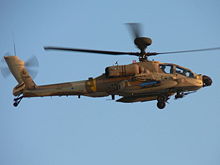
Picture - Israeli Air Force AH-64D Saraph
The Israeli Air Force (IAF) first received AH-64As in 1990, for a total fleet of 42. There was some controversy over the Air Force's choice to purchase Apaches over upgrading existing AH-1 Cobra attack helicopters. In 2000 Israel examined the prospect of acquiring up to 48 Apache AH-64Ds, but US reluctance to share military source code for the software complicated the deal. A previously agreed prospective sale of six AH-64Ds to Israel in 2009 was reportedly blocked by the Obama Administration (pending an interagency review), because of concerns that the helicopters may pose a threat to civilian Palestinians in Gaza. In IAF service, the AH-64A is named Peten (Hebrew: פתן‎, English: python), and the AH-64D is known as Saraph (Hebrew: שרף‎, English: serpent).
The AH-64A was used frequently during the 1990s to attack and destroy Hezbollah outposts in Lebanon, attacking in many weather conditions - day and night. During the al-Aqsa Intifada in 2000, the IAF used the AH-64 to kill senior Hamas figures, such as Ahmed Yassin and Adnan al-Ghoul, with guided missiles. During the morning of 24 May 2001, a privately-owned Lebanese-registered Cessna 152 flew into Israeli airspace and was intercepted by two Israeli AH-64s, one of which shot down the Cessna with an AGM-114 Hellfire missile, killing the pilot. IAF Apaches played a significant role in Israeli air cover during the 2006 Lebanon War.
There have also been accidents involving the Apache helicopter in Israeli service. During the Lebanon War in 2006, two IAF AH-64A helicopters collided, killing one pilot and critically wounding three. In another incident in the conflict an IAF AH-64D crashed due to a malfunction in the main rotor, killing the two crew. This caused the Israel Air Force put on hold further purchases or deliveries of AH-64Ds while investigating with Boeing over the craft's performance envelope.
United Kingdom
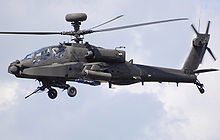
Picture - UK Army Air Corps Westland WAH-64D Apache Longbow displays at a UK airshow
The UK operates a modified version of the Apache Longbow initially called the Westland WAH-64 Apache, and is designated Apache AH1 by the British Army. Westland built 67 WAH-64 Apaches under license from Boeing, following a competition between the Eurocopter Tiger and the Apache for the British Army's new Attack Helicopter in 1995. Important deviations made by AgustaWestland from the US variants of the Apache include replacing the engines with more powerful Rolls-Royce units, and the addition of a folding blade assembly for naval use; allowing British Apaches to operate from Royal Navy warships and auxiliaries.
Before its introduction into service in 2004, several problems were noted, including lacking the ability to securely communicate with other helicopters and a risk of damage to the tail rotor upon use of the Hellfire missiles; the latter problem having been corrected as Hellfires are now routinely carried and used by Apaches in British service. The Apache AH1s have been regularly deployed to Afghanistan, in support of UK and Coalition forces in the south of the country. British Apaches routinely use the Longbow Fire Control Radar in Afghanistan, stating that it improves situational awareness and avoidance of other aircraft during tactical maneuvers.
The Netherlands
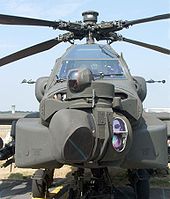
Picture - Royal Netherlands Air Force AH-64D at the Farnborough Airshow, 2006
The Dutch government initially showed an interest in acquiring Apache helicopters in the late 1980s, where it stated that it may purchase as many as 52. A competition held in 1994 against the Eurocopter Tiger and the AH-1 SuperCobra led to the Royal Netherlands Air Force ordering 30 AH-64D Apaches in 1995. Construction for the order started in December 1997, deliveries began in 1999. The Apaches of the RNLAF are equipped with the Apache Modular Aircraft Survivability Equipment (AMASE) system. The AMASE is an advanced Electronic Warfare self-protection system against Infra-Red (IR) missile threats.
The RNLAF Apaches' first deployment was in 2001 to Djibouti, Africa. They were also deployed alongside US AH-64s in support of NATO peacekeeping forces in Bosnia and Herzegovina. In 2004, six Dutch AH-64s were deployed as part of the Netherlands contribution to Multinational force in Iraq to support the Dutch ground forces. The Apaches performed close combat support and display of force missions, along with providing reconnaissance information to ground forces. In February 2006, the Netherlands contribution to NATO forces in Afghanistan was increased from 600 to 1,400 troops and 6 AH-64s were sent in support.
Shortly after Apaches were deployed to Kabul airport as part of the Netherlands contribution to ISAF, on 10 April 2004 a pair of Dutch Apaches came under light gunfire close to the Afghan capital. On 17 December 2007, a RNLAF Apache flew into powerlines during a night flying exercise in the Netherlands, forcing an emergency landing and causing a lengthy blackout in the region.
Saudi Arabia
In the aftermath of the 1991 Gulf War, in which many US Apaches operated from bases within Saudi territory, the government of Saudi Arabia purchased twelve AH-64As for their military. Within the Middle East, Israel's own Apache procurements were motivated as a response to the 1992 Saudi purchase. In August 2006, Saudi officials began negotiations to spend as much as $400 million on upgrades to their Apaches, potentially remanufacturing them into a AH-64D Longbow configuration. In September 2008, the US Government consented to the purchase of twelve AH-64Ds requested by Saudi Arabia.
Commencing in 2009, the Royal Saudi Air Force began using the Apache as an important part of Operation Scorched Earth, launching airstrikes against Houthi rebels operating inside Yemen. In January 2010 the rebels claimed to have shot down an Apache, however this was denied by the Saudi military.
Other and future users
The United Arab Emirates purchased 30 AH-64A helicopters in 1991 and 1994, which they are now upgrading to AH-64D specification. In 2005 Kuwait purchased 16 Longbow helicopters. Egypt also uses the Apache. In September 2003, Greece ordered 12 AH-64D in addition to existing fleet of 20 AH-64A+. Singapore purchased a total of 20 AH-64D Longbow Apache aircraft in two batches between 1999 and 2001. Japan has ordered a total of 50 AH-64Ds, which are being built under license by Fuji Heavy Industries. The first helicopter was delivered to the JGSDF in early 2006; these Fuji-made AH-64Ds are designated "AH-64DJP".
The Apache Longbow is one of several types competing for the Indian Air Force order for 22 attack helicopters. Boeing had backed out of the competition in October 2008, but submitted an Apache proposal in October 2009. South Korea is also interested in acquiring Apache attack helicopters, perhaps as early as by 2012. This move may be in response to plans made by the US to withdraw many of their own Apaches from South Korea. As of August 2009 the purchase remains uncertain, due to considerations of alternative aircraft.
Variants
AH-64A
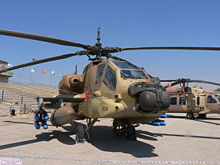
Picture - IAF AH-64A Peten
The AH-64A is the original production attack helicopter. The crew sit in tandem in an armored compartment. It is powered by two GE T700 turbo-shaft engines. The A-model was equipped with the -701 engine version until 1990 when the engines were switched to the more powerful -701C version.
The Japanese Apache variant is based on the AH-64A. Japan's AH-64DJP variant can also be equipped with the AIM-92 Stinger air-to-air missiles for defense.
AH-64B
In 1991 after Operation Desert Storm, the AH-64B was a proposed upgrade to 254 AH-64As. The upgrade would have included new rotor blades, a Global Positioning System (GPS), improved navigation systems and new radios. Congress approved US$82 million to begin the Apache B upgrade. The B program was canceled in 1992. The radio, navigation, and GPS modifications, were later installed on most A-model Apaches through other upgrades.
AH-64C
Additional funding from Congress in late 1991 resulted in a program to upgrade AH-64As to an AH-64B+ version. More funding changed the plan to upgrade to AH-64C. The C upgrade would include all changes to be included in the Longbow except for mast-mounted radar and newer -700C engine versions. However, after 1993 the C designation was dropped.
The upgrades would go forward in the 1990s. With AH-64As receiving the newer engine from 1990, the only difference between the C model and the radar-equipped D model was the radar, which could be moved from one aircraft to another. It was planned to simply designate both versions AH-64D.
AH-64D
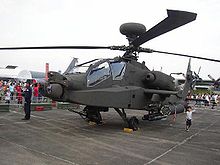
Picture - Republic of Singapore Air Force AH-64D on static display during open house
The advanced model, the AH-64D Apache Longbow, is equipped with an improved sensor suite, a glass cockpit, and weapon systems. The main improvement over the A-variant is the dome installed over the main rotor which houses the AN/APG-78 Longbow millimeter-wave Fire Control Radar (FCR) target acquisition system and the Radar Frequency Interferometer (RFI). The raised position of the radome allows for detection and launching of missiles at targets when the helicopter is hidden by an obstacle (e.g. terrain, trees or buildings). A radio modem integrated with the sensor suite allows a AH-64D to share targeting data with other D-models. This allows a group of Longbow Apaches to fire on targets detected by the FCR of a single helicopter.
The aircraft is powered by a pair of uprated T700-GE-701C engines. The forward fuselage of the aircraft was expanded to accommodate new systems for improved crashworthiness, survivability, navigation, and 'tactical internet' communications capabilities. The first of the upgraded Block II Apaches was delivered to the US Army in February 2003. Block II includes upgrades to the digital communications systems.
Block III aircraft include the following upgrades: improved digital connectivity, the joint tactical radio system, enhanced engines and drive systems, capability to control UAVs, new composite rotor blade, full IFR capability and improved landing gear. The new blades, which successfully completed flight testing in May 2004, increased the Apache's cruise speed, climb rate and payload capability. The US Army now plans to field the first Block III equipped unit in November 2012. The Army awarded a contract to begin initial production of Block III helicopters in October 2010.
Export Apaches
A number of other models have been derived from both AH-64A and AH-64D for export. The British-built AgustaWestland Apache (assembled from kits purchased from Boeing) is based on the AH-64D with several different systems, including more powerful engines and modifications towards naval usage.
Sea Apache
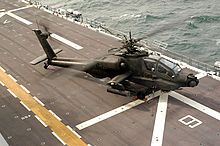
Picture - A US Army Apache aboard USS Nassau during Joint Shipboard Weapons and Ordnance training
Naval versions of the AH-64A for the United States Marine Corps and Navy were examined from 1984 to 1987. The Canadian Forces Maritime Command also examined the prospect of using a modified Apache in naval service. Multiple concepts were studied with altered landing gear arrangements, improved avionics and weapons. Funding for the naval version was not provided, and the Marine Corps has continued to use the AH-1 SuperCobra. The US expressed interest in trials onboard HMS Ocean to test the suitability of the AgustaWestland Apache used by the British Army.
Operators
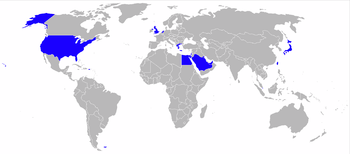
Picture - World map of military operators of the AH-64 Apache. Current military operators in blue.
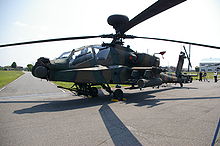
Picture - JGSDF AH-64D
Egypt
Egyptian Air Force ordered 36 AH-64As in 1995 and they were being upgraded to AH-64D configuration in 2005. In 2009 Egypt requested 12 AH-64D Block II Apaches through a Foreign Military Sale. Egypt had 35 AH-64Ds in operation as of January 2010.
Greece
Hellenic Army received 20 AH-64As in 1995 and ordered 12 AH-64Ds in 2003. Had 19 AH-64A and 12 AH-64D helicopters in service in January 2010. An AH-64D crashed on 30 July 2010 after take off due to technical failure.
Israel
Israeli Air Force has 37 AH-64As and 11 AH-64Ds in inventory as of January 2010.
113th Squadron ("The Hornet Squadron")- Ramon Airbase
190th Squadron ("The Magic Touch Squadron)- Ramon Airbase
Japan
Japan Ground Self-Defense Force has ordered 50 AH-64Ds as of 2005, with 2 AH-64s in use as of January 2010.
Kuwait
Kuwait Air Force had 16 AH-64Ds on order in 2004, with all 16 AH-64Ds in inventory as of January 2010.
17th Attack Squadron- Ali Al Salem Air Base
20th Attack Squadron- Ali Al Salem Air Base
Netherlands
Royal Netherlands Air Force received 30 AH-64Ds as of 2005, with 29 AH-64Ds in service as of 2010.
301st Squadron- Gilze-Rijen Air Base
Republic of China (Taiwan)
Republic of China (Taiwan) Army ordered 30 AH-64D Block III helicopters, additional GE T700-701D engines, weapons, and related systems through a Foreign Military Sale in 2008.
Saudi Arabia
Royal Saudi Air Force has 12 AH-64As in service as of January 2010.
Singapore
Republic of Singapore Air Force has 20 AH-64Ds in use as of January 2010.
120 Squadron- Sembawang Air Base
United Arab Emirates
United Arab Emirates Air Force received 30 AH-64As as of 2005. UAE has 12 AH-64As and 14 AH-64Ds in service as of January 2010.
United Kingdom
See AgustaWestland Apache
United States
United States Army has 741 AH-64s (241 AH-64As, and 500 AH-64Ds) in use as of January 2010.
Active Duty
Air Cavalry Brigade, 1st Cavalry Division
1st Battalion, 227th Aviation Regiment
4th Battalion, 227th Aviation Regiment
Combat Aviation Brigade, 1st Armored Division
Combat Aviation Brigade, 1st Infantry Division
1st Battalion, 1st Aviation Regiment
Combat Aviation Brigade, 2nd Infantry Division
4th Battalion, 2nd Aviation Regiment
Combat Aviation Brigade, 3rd Infantry Division
1st Battalion, 3rd Aviation Regiment
Combat Aviation Brigade, 10th Infantry Division
1st Battalion, 10th Aviation Regiment
Combat Aviation Brigade, 25th Infantry Division
Combat Aviation Brigade, 82nd Airborne Division
1st Battalion, 82nd Aviation Regiment
Combat Aviation Brigade, 101st Airborne Division
1st Battalion, 101st Aviation Regiment
159th Combat Aviation Brigade, 101st Airborne Division
3rd Battalion, 101st Aviation Regiment
12th Combat Aviation Brigade
2nd Battalion, 159th Aviation Regiment
3rd Battalion, 159th Aviation Regiment
16th Combat Aviation Brigade
110th Aviation Brigade (TRADOC)
1st Battalion, 14th Aviation Regiment
Army National Guard
Combat Aviation Brigade, 28th Infantry Division (PA ARNG and NJ ARNG)
1st Battalion, 104th Aviation Regiment
1st Battalion, 224th Aviation Regiment
Combat Aviation Brigade, 29th Infantry Division (MD ARNG)
1st Battalion, 285th Aviation Regiment
Combat Aviation Brigade, 34th Infantry Division (MN ARNG, ND ARNG and ID ARNG)
2nd Battalion, 147th Aviation Regiment
Combat Aviation Brigade, 35th Infantry Division (MO ARNG, NE ARNG and UT ARNG)
1st Battalion, 135th Aviation Regiment
Combat Aviation Brigade, 36th Infantry Division (TX ARNG, CO ARNG, AL NG and KS ARNG)
1st Battalion, 149th Aviation Regiment
Combat Aviation Brigade, 38th Infantry Division (IN ARNG)
1st Battalion, 130th Aviation Regiment
Combat Aviation Brigade, 40th Infantry Division (CA ARNG)
1st Battalion, 211th Aviation Regiment
Combat Aviation Brigade, 42nd Infantry Division (NY NG)
1st Battalion, 151st Aviation Regiment
United States Army Reserve
11th Theater Aviation Command
1st Battalion, 158th Aviation Regiment
8th Battalion, 229th Aviation Regiment
Specifications (AH-64A/D)
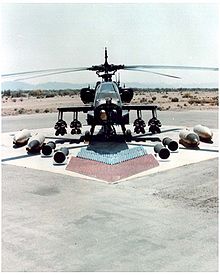
Picture - Weapon loadout of the AH-64 Apache
Data from Jane's Information Group, Bishop
General characteristics
Crew: 2 (pilot, and co-pilot/gunner)
Length: 58.17 ft (17.73 m) (with both rotors turning)
Rotor diameter: 48 ft 0 in (14.63 m)
Height: 12.7 ft (3.87 m)
Disc area: 1,809.5 ft² (168.11 m²)
Empty weight: 11,387 lb (5,165 kg)
Loaded weight: 17,650 lb (8,000 kg)
Max takeoff weight: 23,000 lb (10,433 kg)
Powerplant: 2x— General Electric T700-GE-701 and later upgraded to T700-GE-701C (1990-present) & T700-GE-701D (AH-64D block III) turboshafts, -701: 1,690 shp, -701C: 1,890 shp, -701D: 2,000 shp (-701: 1,260 kW, -701C: 1,490 kW, -701D: 1,490 kW) each
Fuselage length: 49 ft 5 in (15.06 m)
Rotor systems: 4 blade main rotor, 4 blade tail rotor in non-orthogonal alignment
Performance
Never exceed speed: 197 knots (227 mph, 365 km/h)
Maximum speed: 158 knots (182 mph, 293 km/h)
Cruise speed: 143 knots (165 mph, 265 km/h)
Range: 257 nmi (295 mi, 476 km) with Longbow radar mast
Combat radius: 260 nmi (300 mi, 480 km)
Ferry range: 1,024 nmi (1,180 mi, 1,900 km)
Service ceiling: 21,000 ft (6,400 m) minimum loaded
Rate of climb: 2,500 ft/min (12.7 m/s)
Disc loading: 9.80 lb/ft² (47.9 kg/m²)
Power/mass: 0.18 hp/lb (0.31 KW/kg)
Armament
Guns: 1x— 30 x— 113 mm (1.18 x— 4.45 in) M230 Chain Gun with 1,200 rounds
Hardpoints: Four pylon stations on the stub wings. Longbows also have a station on each wingtip for an AIM-92 ATAS twin missile pack.
Rockets: Hydra 70 air-to-ground rockets
Missiles: Typically AGM-114 Hellfire variants, however, AIM-9 Sidewinder, and AIM-92 Stinger may also be carried.
Avionics
Lockheed Martin / Northrop Grumman AN/APG-78 Longbow fire-control radar (Note: can only be mounted on the AH-64D)
Notable appearances in media
Aviation and Missile Research, Development, and Engineering Center
United States Army Aviation and Missile Command
U.S. Helicopter Armament Subsystems
Related development
AgustaWestland Apache
Comparable aircraft
Agusta A129 Mangusta
AH-1Z Viper
Bell YAH-63
CAIC WZ-10
Denel AH-2 Rooivalk
Eurocopter Tiger
HAL Light Combat Helicopter
Kamov Ka-50
Mil Mi-24
Mil Mi-28
TAI/AgustaWestland T-129
Related lists
List of helicopters
List of active military aircraft of the United States
List of aviation shootdowns and accidents during the Iraq War
Bibliography
TM 1-1520-251-10 Technical Manual for Helicopter, Attack, AH-64D Longbow Apache, U.S. Army.
Bernstein, Jonathan. AH-64 Apache units of operations: Enduring Freedom an Iraqi Freedom. Oxford : Osprey Publishing, 2005. ISBN 1-84176-848-0.
Bishop, Chris. Apache AH-64 Boeing (McDonnell Douglas) 1976-2005. Osprey Publishing, 2005. ISBN 1-84176-816-2.
Donald, David. "AH-64A/D Apache and AH-64D Longbow Apache". Modern Battlefield Warplanes. AIRtime Publishing Inc, 2004. ISBN 1-880588-76-5.
Government Accounting Office. Staff Study: Advanced Attack Helicopter. Washington, D.C.: US Government Accounting Office, 1974.
Office of the Assistant Vice Chief of Staff of the Army (OAVCSA). An Abridged History of the Army Attack Helicopter Program. Washington, DC: Department of the Army. 1973.
Richardson, Doug and Lindsay Peacock. Combat Aircraft: AH-64 Apache. London: Salamander Books, 1992. ISBN 0-86101-675-0.
Living Warbirds: The best warbirds DVD series.
Source: WikiPedia